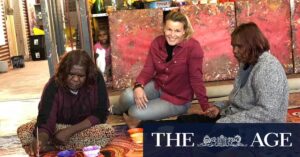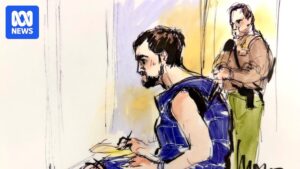
In a dramatic turn of events, new video footage has emerged showing a heated altercation between police and protesters in Belmore, leading to serious injuries for Hannah Thomas, a former Greens candidate. The incident has sparked widespread debate over the enforcement of anti-protest laws and the conduct of law enforcement officers.
Thomas, who recently ran against Prime Minister Anthony Albanese in the Grayndler seat, attributes her injuries to the actions of New South Wales Premier Chris Minns and Police Minister Yasmin Catley. She claims their “draconian anti-protest laws” have emboldened police to act with “extreme violence and brutality.” The confrontation took place outside SEC Plating, a company alleged by protesters to supply plating services for F-35 jets used by the Israel Defence Forces (IDF).
Details of the Incident
The video, which has been widely circulated, captures a tense exchange between police officers and protesters questioning the legality of a move-on order. Officers are seen instructing the protesters to leave the suburb of Belmore for 24 hours, without citing specific legislation. When activist Zack Schofield pressed for clarification, a male officer responded by forcibly removing him, escalating the situation into a scuffle.
Thomas was left with a bruised and swollen eye, her face bloodied as she sat in an ambulance following her arrest. Five individuals, including Thomas, have been charged with various offenses and are set to appear in Bankstown Local Court on August 12.
Legal and Political Reactions
The incident has raised questions about the application of new powers designed to prevent protests at places of worship. SEC Plating is located across from the Teebah Islamic Association Mosque, adding a layer of complexity to the legal discourse. Despite the proximity, Assistant Commissioner Brett McFadden clarified that none of the charges were related to the new legislation, asserting that the move-on orders were issued due to alleged obstruction of pedestrian access.
Greens MP Sue Higginson has called for all charges against the protesters to be dropped, emphasizing the severity of Thomas’s injury during the arrest. “I welcome the declaration that the police assault of Hannah Thomas has been declared a critical incident, but this must be recognized as the minimum requirement when police actions cause serious injury,” Higginson stated.
Government and Police Stance
Premier Chris Minns has maintained a cautious stance, refraining from condemning police actions while the investigation is ongoing. Speaking at an event, Minns expressed regret over Thomas’s injury but denied that the new laws were applied during the protest.
Assistant Commissioner McFadden noted that a critical incident could not be declared initially due to the lack of medical records from Thomas. However, police are now actively reviewing social media and video evidence to piece together the events leading to her injury.
Implications and Future Outlook
This incident underscores the ongoing tension between law enforcement and protest groups, particularly in the context of heightened political activism. The use of move-on orders and the broader implications of anti-protest legislation remain contentious issues, with potential ramifications for civil liberties and public order.
As the legal proceedings unfold, the case will likely serve as a litmus test for the balance between maintaining public safety and upholding the right to protest. The outcome could influence future legislative measures and police protocols in handling demonstrations.
The community and stakeholders will be closely watching the developments, eager to see how the courts will address the charges and the broader implications for protest rights in New South Wales.







